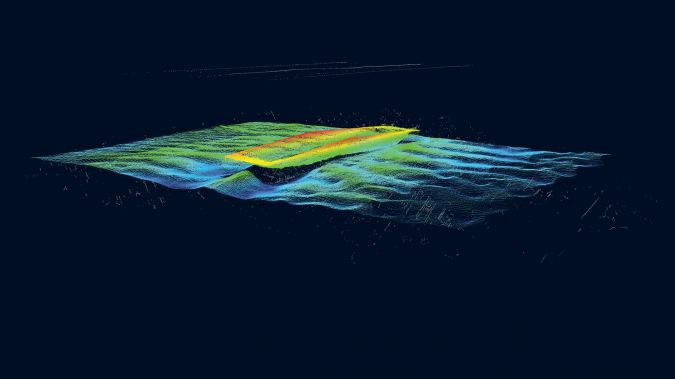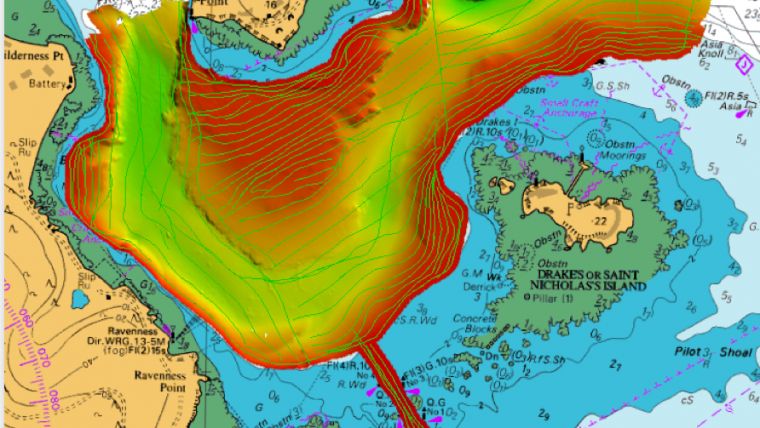AI Making Waves in the Maritime Field
Andy Hoggarth’s role at the helm of BD at CARIS is to understand trends in the business space industry as it evolves and to translate these from idea to product. Given the spectrum of his expertise, he reflects on the current state of play and future possibilities for the fields of hydrography, marine geomatics and ocean science. He shares his insights on current and future trends in the field, articulating the value of artificial intelligence (AI) in reducing costs and processing time whilst increasing data accuracy and quality.
How AI Can Help Businesses
Everyone is inundated with data these days, and the data deluge continues to flow. Data is generated from myriad internal and external sources including satellites and citizen-sourced. Hoggarth’s strategic work at CARIS looks at how hydro enterprises can better manage and process their data, and he suggests that AI can certainly help. Hoggarth says that: "AI is one of the main trends people need to be aware of. One trend that we’re seeing is using AI to perform some of the tasks that were manually intensive and potentially subjective, such as multi-beam sonar technology for seafloor mapping: AI means we can make decisions so much more quickly".
AI is an emerging technology that can and is being leveraged to meet the challenges of the global hydrographic community. The introduction of AI and ML capabilities will enable maritime enterprises to shift from being product-centric to data-centric, introducing possibilities for enterprises to expand their product and service portfolios. This could give rise to new business opportunities and greater client satisfaction due to faster delivery, contributing to growth.

Hoggarth goes on to explain that: "some agencies are at the cutting edge, experimenting with some of the new AI tools available, and reaping the rewards. AI tools have been implemented across multiple sectors within the maritime industries, with entities like navy and government proving to be especially interested in emerging technologies like AI, although the private sector tends to be very early adopters in this space”.
Hoggarth is clear that whilst AI and ML are powerful tools for the field, they are just tools, and they cannot replace human expertise required to plan and oversee the application of AI in hydrography. In fact, the most effective setup is for employees to gain new, valued expertise in working with and overseeing AI, using it as a secret weapon to achieve business objectives via more accurate, faster data processing with oversight from trained expert employees. This will increase efficiency and speed of output, enable employees to obtain new, valuable expertise and develop their professional prowess in ways that grow the business. "This is game-changing”, he says, noting the unprecedented ability AI offers to handle new sources of data and obtain better quality results faster.
AI Opportunities in the Maritime Industries
The current standard for data cleaning involves time-consuming and labour-intensive manual work like dot-killing, as well as simple filters, statistical filters plus terrain model binning and filtering. Regardless of the method or filter type, everyone faces processing challenges. Complex features and steep slopes, for example, pose problems for the professional tasked with cleaning the data. Hoggarth explains how CARIS has just launched pioneering sonar noise classification software that detects all the following types of noise: cavitation/bubble sweep, loss of bottom on outer beams, loss of bottom lock and false returns from the water column.
Hoggarth’s company, Teledyne CARIS, has been making software for the marine GIS community for 40 years and is renowned in the field for its products and client service. CARIS Mira-AI is their new, robust, secure cloud-based platform that hosts their AI solutions. The platform has undergone years of considerable beta-testing by a group of public and private sector companies. Hoggarth says that this major initiative has been "a community-driven collaboration", pointing out that when it comes to machine learning (ML) and AI, "you must train the algorithm, you want data that has been trained, processed, so we can learn from how the human did it in their operations".
During development, Hoggarth’s teams taught the algorithm numerous use cases, drawing on real-world data, so that the algorithm recognizes real features on the seafloor, and that noise signatures are errors. This deep ML approach has resulted in an extraordinarily precise tool, the Sonar Noise Classifier, the first offering available out of the CARIS Mira-AI portfolio. The Sonar Noise Classifier, launched in early February 2020, reduces the need for manual cleaning, enabling employees to focus their expertise on the other important aspects of the work that machines cannot do.
Hoggarth believes that: "the availability of training datasets is always a challenge across the geospatial realm: the algorithm is only ever as good as the data you have access to, and partnerships are critical". He goes on to explain that the work of his company is unique because CARIS wanted to create the ability to classify high-density point cloud 3D data sets, whereas most of the work in this space to date has been related to analysing flat, one-dimensional images.
This is pioneering work, and it’s very challenging. CARIS software responds to these kinds of challenges, enabling the professional to analyse data with an incomparably high level of accuracy. The software provides insights regarding a multitude of data, allowing the hydro professional to determine with precision things like what is noise and what is real; characteristics like where the seafloor is sandy or where the shipwreck is. Thinking about where the future is headed, Hoggarth predicts that: "classification at the object level is the next step".
How AI Can Help
Another important element of the equation, Hoggarth says, is computer power, stating that: "it’s critical, cloud power specifically”’. Computing hardware is particularly key. The CARIS process is to: "make use of their [client] server arrays, take the data, anonymise it, send it to the cloud. Then, our algorithm runs, results are generated and passed back to the local machine". Making use of the cloud in such a way is ideal for enterprises, who don’t have to purchase computer power, train multiple employees in how to use and then ensure expensive hardware is kept up to date.
Going forward, businesses need to explore the possibilities for introducing cloud computing capabilities into their data processing workflows. There are two models that CARIS offers, firstly: "enterprises could use our software and connect to the cloud, it’s less bandwidth than you imagine it to be. The software runs it through, then brings it back locally".
Most are likely to be better off with the cloud, because "it provides greater benefits with regard to scalability, security and responsiveness” to the end-user. In some contexts, he agrees that option two, going ‘on-premise’ with high-end computing, might be preferable or necessary, such as in certain government contexts where all data must remain on-site or in settings without an internet connection but, in general, the cloud option is ideal. AI can be applied to legacy data as well as embedded as part of project design for new projects, enabling businesses to seamlessly transition to incorporating the technology where possible.

Value staying current with hydrography?
Stay on the map with our expertly curated newsletters.
We provide educational insights, industry updates, and inspiring stories from the world of hydrography to help you learn, grow, and navigate your field with confidence. Don't miss out - subscribe today and ensure you're always informed, educated, and inspired by the latest in hydrographic technology and research.
Choose your newsletter(s)
























